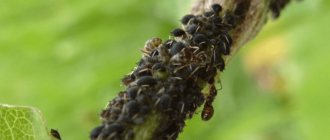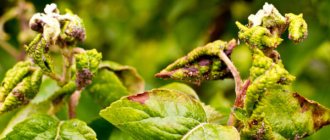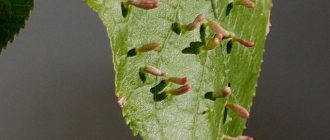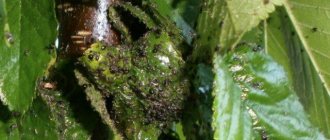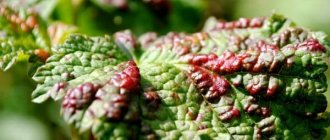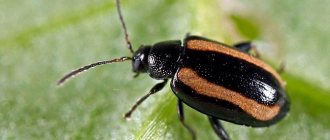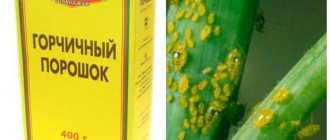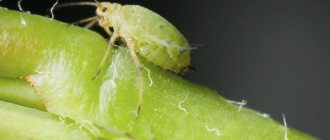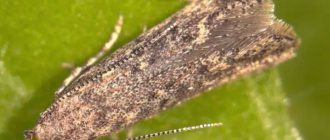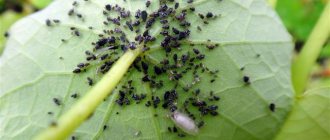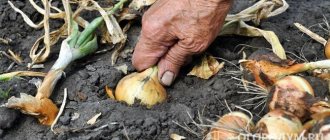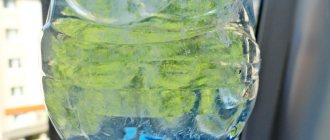Home / Pests and diseases
Back
Published: 06/09/2019
0
Rate this post
Hello, dear readers! Aphids are a pest that affects many crops - vegetables, fruits, berries, flowers. Gardeners who grow honeysuckle on their plots pursue two goals - to decorate their garden and get a harvest, because everyone likes the beneficial fruits of this plant.
However, pests also do not ignore this crop and love to feast on its juices. Aphids on honeysuckle can cause a lot of unpleasant moments, but there are ways to combat this pest.
- 1 Harm of aphids to honeysuckle
- 2 How can you get rid of aphids on honeysuckle?
- 3 How to fight aphids on honeysuckle using folk remedies?
- 4 How to treat aphids on honeysuckle?
Fungal diseases
Fungal diseases are caused by spores of pathogenic fungi. Without treatment, the death of the bush is possible as early as next season. Let's look at their main types.
Ramulariasis
The initial stage of the disease involves the appearance of brown spots with a more pronounced frame on the foliage of the bush. Next, the entire crown of honeysuckle is affected, the foliage falls off along with the ripe spores, which leads to contamination of the soil. The plant weakens and its appearance deteriorates. The spores can survive the winter period and continue to spread with the onset of spring.
External manifestation of ramulariasis
To treat the disease, remove infected shoots and fallen leaves.
This action must be performed with extreme caution so as not to spread spores. The collected mass is burned
Copper-containing preparations are used as prophylaxis. This can be copper sulfate, Bordeaux mixture and “Fungicide”.
Cercospora
Appears in the form of swamp-colored spots. Subsequently, their color changes to gray or red with a dark edging. The spread and treatment of the disease occurs in the same way as in the previous paragraph.
Preventive actions include several points:
- Timely pruning of bushes to create optimal ventilation.
- Fertilizer with minerals to support the immune system of honeysuckle.
- Spraying the plant before the buds open or after harvesting with Cuprozan, Fungicide or Bordeaux mixture.
Manifestation of cercospora
Drying branches
Despite the fact that it is only the middle of the season, the leaves and shoots begin to turn yellow, darken, and then wither and dry out. Brown tubercles appear in which spores ripen. To save the bush, the infected parts are removed and then burned. As a preventive measure, the plant is sprayed with Bordeaux mixture even during its awakening after the winter period.
Symptoms of drying branches
Powdery mildew
A white coating, similar to a cobweb, envelops the foliage and young shoots. Subsequently, the entire plant is covered with it. The leaves change color and fall off. The shoots dry out and the bush weakens. Treatment consists of removing the infected parts and treating the honeysuckle with sulfur-containing preparations as soon as possible. To avoid disease, do not forget to remove fallen leaves.
Manifestation of powdery mildew
Blackening of foliage
Black spots appear on shoots and leaves. Over time, they enlarge and encircle the entire leaf blade, which leads to their shedding. The fruits of the plant can also be infected. To save the bush, the affected parts should be removed and burned. For prevention, treatment with Bordeaux mixture is carried out in early spring or after harvest.
Signs of blackening foliage
Frost shoots
In spring, cracks appear on the shoots, in which fungi settle. Due to their vital activity, the plant loses strength and dries out.
Preventive actions include two points:
- After the winter period, a thorough inspection of the honeysuckle is carried out. If affected branches are identified, it is necessary to get rid of them.
- Carrying out treatment with Bordeaux mixture after harvesting.
Formation of cracks on shoots due to frost damage
Cancer
First of all, the bark is infected. This is expressed in the formation of wounds and their further fusion, after which ulcers form. The bush is drying out. The disease is incurable and dangerous for neighboring plants, as it spreads quickly. Therefore, the only salvation is to remove all the bushes. With the onset of spring or at the end of flowering, be sure to spray the plant with Bordeaux mixture.
Honeysuckle Cancer Symptoms
Fungal diseases
They appear, as a rule, in conditions of high humidity and the root system begins to suffer the most. The first signs of fungus are the appearance of spots, shrinkage and drying of the leaves.
A fungal disease can be understood by the color of the spot:
if large dark brown spots appear, this indicates the appearance of ramulariasis;
the presence of round dark brown spots means the formation of cercospora;
powdery mildew appears as a white coating;
Treatment and prevention: there are a lot of methods of getting rid of it. You can treat the plant with Fundozol, Topaz, copper-soap solution, wood ash, and soda solution.
Read here about the beneficial and harmful properties of honeysuckle.
Why does honeysuckle dry out with ramularia?
Sometimes drying out, first of individual sections of the leaves, and then of the entire foliage, is a consequence of the activity of fungi belonging to the Ramularia family. Visually, such marks on the foliage of the affected plant look like yellow-brown or brown spots with a dark rim.
The shape of the spots can be either round or irregular. Moreover, over time they grow, and the area affected by honeysuckle disease, such as ramularia or spotting, expands. Ripe spores in the form of white powder fall off several times during the growing season from places where the fungus accumulates and are scattered on the root litter and healthy leaves. See honeysuckle honeysuckle photo.
The danger of the disease lies not only in the fact that the honeysuckle crown dries out and the plant weakens, but also in the ability of the spores to overwinter in the middle zone and spread again in the spring. Therefore, as safety measures:
- carefully remove the affected shoots;
- collect fallen old leaves;
- All parts of plants infected with fungus are burned.
Organics and chemistry against aphids
Among the plants that can repel aphids are onions, garlic, and chamomile. They are the ones that need to be planted near those crops that are subject to pest attacks. It is also recommended to find information about the plant neighborhood so that the yield is increased and insects do not attack.
Some gardeners additionally feed their plantings with nitrogen fertilizers. But it is precisely such fresh greens that most often attract aphids.
The most common and accessible chemical product is ordinary soap with vegetable oil. This mixture is able to envelop the bodies of aphids and prevent them from breathing, since they do this through the skin.
The prepared consistency is applied to honeysuckle and other plants only in the evenings, when the aphids are already resting. The procedure is repeated every other day until the aphids completely die. It is worth remembering that this way you can get rid of both pests and beneficial insects.
You can also use tomato leaves. To do this, they are cut and filled with water overnight. Then the infusion is filtered, more water is added, and honeysuckle is sprayed from the bottle. In this case, we must not forget about the lower part of the leaves.
Fighting aphids on honeysuckle or any other plant is a prerequisite for obtaining a good harvest. What exactly to choose for this, each gardener chooses independently.
Landing
For planting, it is recommended to choose bushes no more than 1.5 meters high. To ensure cross-pollination, it is worth purchasing planting material of several varieties, with different tastes.
When planting honeysuckle seedlings, select an area with good sunlight, although the shrubs tolerate light partial shade well. The quality of the soil is not particularly important. It is undesirable to place honeysuckle on dry sandy soils and swampy areas where water stagnates. Usually it is planned to plant edible honeysuckle in the spring, but autumn work is also practiced, before the onset of frost, so that the root system has time to take root.
In spring, you should not plant shrubs after the buds begin to swell. Edible honeysuckle is planted after the onset of stable heat, at above-zero night temperatures.
Planting pattern: 40x40x40 cm, the distance between bushes should not be less than 1.5 m, in rows - at least 2 meters. The calculation is made taking into account the characteristics of the variety: height and width of the bush. For full growth and fruiting, you should follow the planting rules; add the following to the hole:
- 10-12 rotted manure;
- 100 g superphosphate;
- 30-50 g of potassium sulfate;
- 300-400 g of wood ash.
Fertilizers are thoroughly mixed and a mound is formed. A seedling is placed on it, the roots are straightened, avoiding bending. Cover with soil and compact. Water generously.
The ground is mulched with bark, sawdust, peat or hay to retain moisture. The branches are not pruned.
At the dacha, shrubs are planted along fences and fences and used for zoning areas. Mature bushes create beautiful compositions, decorating the garden plot. Over time, young shoots grow from the old bush, which, if desired, are separated for planting in another place.
Aphid repellent plants
Most often, pelargonium and spicy basil are planted next to shrubs. Plants repel pests with strong aromas that do not cause discomfort to people.
Geranium and basil are often used against plant pests in the home. Repellents feel great in ordinary pots and boxes.
Many gardeners place beds of fragrant herbs (mint, citrus fruits, marigolds, basil, thyme) near the bushes. Repellents protect not only honeysuckle, but also surrounding cultural plantings within a radius of several meters.
Methods for removing aphids on honeysuckle
There are several ways to remove such a malicious pest. Among them are mechanical, biological and chemical.
The mechanical method involves removing aphids with good water pressure, but if there are only a few of them, you can pick them all out with your hands.
Some prefer, so to speak, to invite insects and birds that feed on aphids to the garden plot. These include ladybugs, lacewings and some wasps. In order for them to be found in the garden, it is necessary to plant spicy herbs, as well as nettle, mallow and soporific poppy. Birds include linnets, sparrows, tits and other species.
Of course, the natural accumulation of such predators on aphids will not be enough, so you can often buy ladybird larvae in specialized stores and release them on your site.
IMPORTANT! Aphids love linden trees very much, so you can’t grow valuable crops near them to avoid pests.
Pest protection and pest prevention
Simple prevention will help prevent white plaque on honeysuckle leaves and other diseases, which consists of:
- Choosing healthy planting material.
- Compliance with the rules of plant agricultural technology.
- Proper selection of varieties that are adapted to certain climatic conditions.
- Proper watering without stagnation of water at the roots or drought of the soil.
- Timely removal of weeds and loosening of the soil.
- Carrying out sanitary pruning.
Very often, the answer to the questions of why honeysuckle leaves turn black, which is why an infection or fungus develops, is damage to the plant by insects. Pests spread most of the bacteria, fungal spores and viruses. Colonies also cause the vine to become weak, metabolic processes are disrupted, and immunity to diseases is lost. Despite the fact that only some parasites pose a danger to the plant, they are the ones who spread diseases.
The most common pests are:
- Aphids are insects up to 7.5 mm long with developed heads, legs and antennae. All gardeners should know what aphids are on honeysuckle and how to treat the plant. After all, the pest is dangerous throughout its development and for all parts of the vine. Aphids settle on leaves, buds, and young shoots. The insect sucks out the juice, depleting the honeysuckle. During its life, the parasite secretes so-called “copper dew”, on which a variety of fungal infections develop. To eliminate the insect, use Aktellik, Confidor, Aktara, Elexar. Spraying the bush in calm, clear weather with tobacco infusion with the addition of laundry soap (100 g of tobacco is infused in 10 liters of water for 24 hours) has also proven to work well.
- The leaf roller is a pest that feeds on the vegetative organs of the plant. The adult is a butterfly with a wingspan of up to 2.5 cm, the larvae are caterpillars up to 2 cm.
- Scale is a common “plaque” in the garden and on houseplants. They suck out the juice, thereby weakening the plant. A depressed state is an excellent breeding ground for infection. If no action is taken, the plant dies. Scale insect on honeysuckle, how to fight? In the summer, with a break of 14 days, the vine is sprayed with Rogor and Actellik.
- Flies are insects that attack plants with great intensity. The insects themselves are not harmful, but their larvae - worms in honeysuckle - can destroy the fruit in a few weeks. Prevention - spring spraying with broad-spectrum insecticides (Zolon, Gardona, Nexion, Chlorophos).
Common honeysuckle pests: photos and descriptions
The roseate leaf roller is a small, heavily pubescent brown butterfly whose caterpillars eat young foliage located on actively growing shoots. Sometimes the growing points of the honeysuckle, in the photo, suffer from pests, and the damaged parts of the bush combine into a dense lump covered with cobwebs.
The honeysuckle fingerwing, or rather the caterpillar of this brownish or gray butterfly, penetrates deep into the ovary and eats not only the pulp, but also the seeds. This leads to premature coloring of fruits blue and their dropping, which, if there is an abundance of pests, can seriously reduce plant yields.
Honeysuckle aphid is the most frequent, but always unwanted guest on the honeysuckle bush. During the season, at least two generations of this honeysuckle pest may appear, the photo of which well reflects the widespread nature of the damage.
The damage caused by adult aphids and their larvae is expressed in the weakening of shrubs by sucking juices from leaves and young shoots.
One of the effective ways to combat aphids is to treat honeysuckle with an infusion of tobacco dust with the addition of fish solution at the rate of 100 grams per 10 liters of water. A layer of liquid should cover all foliage and shoots affected by pests. To do this, spraying is carried out in dry weather and the bush is treated from all sides.
The gooseberry moth is a large motley butterfly that lays eggs in mid-summer, from which caterpillars soon emerge feeding on leaves and young growth.
Willow and acacia scale insects are pests of honeysuckle, as in the photo, attaching to shoots and sucking juices from them. As a result, the plant weakens greatly. Fruiting fades, and after some time the bush dies.
Sometimes on the leaves of honeysuckle you can see winding stripes with a dried out and pale surface. This is the result of the activity of larvae that develop from eggs laid into the thickness of the leaf blade by various types of leaf miner flies.
By making winding passages in the foliage and feeding on plant sap, as in the photo, the honeysuckle pest interferes with the process of photosynthesis and slows down the growth of the bush.
Treatment of honeysuckle bushes with chemical insecticides should be carried out in the form of fine-drip irrigation and only in dry weather. A day or two after spraying, check the effectiveness of the procedure and, if necessary, re-treat.
At the same time, we must not forget that the spring use of chemicals for edible honeysuckle is unacceptable, otherwise toxic drugs cannot be avoided on the ovaries. In the fall, be sure to prune and destroy all branches and foliage damaged by pests and diseases, including those that have already fallen.
Chemical treatment against aphids
In early spring, before the buds open, honeysuckle bushes are treated. Spraying is carried out with chemical insecticides:
- "Aktellikom";
- "Confidor";
- "Rogorom";
- "Karbofos";
- "Trichlorometaphos 3";
- "Keltan."
During processing, eggs that have overwintered in the ground and on the lower parts of the branches die. If the product gets on a mature individual, it dies immediately. The insecticidal effect lasts 25–30 days.
It is necessary to irrigate honeysuckle tufts with insecticides in the evening, when there is no risk of sunburn on the leaves. After chemical treatment, it is necessary to cover the bush with film and leave it until the morning. This will increase the effectiveness of the procedure.
Sources of danger from honeysuckle
Honeysuckle was introduced into cultivation not so long ago, so it has few diseases and pests. True, until recently no one damaged it at all, but as more and more large-fruited and sweet varieties were developed, the plant became overgrown with a “bouquet” of diseases and pests.
Honeysuckle pests
Honeysuckle aphid. Appears on young shoots. The leaves curl, turn yellow and dry out, and shoot growth stops. The drugs Actellik and Confidor are suitable for destruction - they are used in early spring, as soon as the leaves bloom. After harvesting, the bushes are sprayed with an infusion of ash and garlic.
Scale insects and false scale insects. This pest is well known to lovers of indoor plants, on which it often parasitizes. Honeysuckle is damaged by acacia, apple and willow scale insects. Insects attach themselves to the bark and suck out the sap of the plant, which can cause its death. The drugs Rogor and Actellik will help you cope with them, and folk remedies include spraying with kerosene.
Ticks. Honeysuckle is parasitized by several species of mites. These microscopic insects especially “love” thickened, shaded and waterlogged bushes. The leaves turn brown and fall off prematurely, become covered with sooty fungus, and the edges of the blades become wavy. Any acaricide is suitable for treatment: Confidor, Actellik, etc.
Fingerwing. This is a caterpillar that eats the pulp of unripe berries, causing them to wrinkle and fall off. Any pyrethroid drug will help to cope with the pest.
Leaf-eating caterpillars. They feed on leaves, without causing much harm to the plant, but reducing its decorative value. These can be sawflies, moths, leaf rollers. They gnaw out the pulp of the plate, leaving the petiole and veins intact, or roll the leaves into dry balls entangled in cobwebs.
Caterpillars are not difficult to get rid of. They can be collected manually from time to time, and if the pests have spread en masse, the bushes can be treated with preparations against leaf-eating insects: Iskra, Inta-Virom, etc.
What plants is it suitable for?
A soap solution against aphids is universal and helps get rid of pests on any plants. If regular soap is not available, you can get rid of aphids by applying tar soap to the plants.
Fruit trees
Aphids suck sap from tree leaves, spoil shoots and leave behind a substance that attracts other harmful insects. As a result, the foliage of fruit trees turns yellow and then dies. As a result, the yield level decreases. The plant becomes vulnerable to diseases and fungi.
To remove aphids, you need to use soap in solid or liquid form. First you need to grate the soap on a coarse grater. After this, you need to dilute 1 liter of warmed water. The required amount of soap is added to it.
This product covers the leaves with a film that makes it difficult for insects to move. In addition, laundry soap reduces the risk of plant disease.
Rose
Usually in the spring, aphids appear on rose bushes. It damages the stems and peduncle, sucking the juice from it. As a result, the rose dries out, its leaves curl and are affected by fungus. The bush dies.
To prevent this, you need to use soap. For a liter of warm water, take 50 grams of solid and 2 teaspoons of liquid. Every evening you need to spray the stems and foliage of the rose, after two weeks the pest will disappear from the flower.
cucumbers
Aphids on cucumbers cause their death in just a couple of days. Plant leaves turn yellow and fall off, and ovaries do not form. Therefore, you need to use means that will prevent this.
A mixture of ash and soap helps insects stick to the stem and leaves. To create a solution, you need to mix 200 grams of ash and 50 grams of soap per 10 liters of warm water. Stir the mixture and sprinkle it on the cucumber shoots.
Currant
The harmful insect damages the bush, reducing productivity and spoiling the inflorescences. A soap solution will help you cope with aphids on currants. This component interferes with the feeding of aphids, making it difficult for them to move.
You can use soap in both liquid and solid form. To protect the currant bush, you need to dilute 300 grams of the product in 10 liters of boiled water. After this, you need to spray the plant several times a day.
Pepper
The insect appears on peppers due to the juicy fruits of the plant. After the aphids appear, the pepper leaves will begin to wither and deteriorate. As a result, the plant may not produce a harvest at all.
A soap solution will help exterminate the harmful insect. You need to dilute 5 grams of product per 1 liter of water. After this, the solution should be infused for 5 hours. When the deadline is up, you can spray the plant bush. In order for aphids to completely disappear from peppers, you need to spray the bushes 3-4 times.
Cabbage
After the appearance of aphids on the cabbage, various harmful microorganisms begin to multiply - rot, fungi, mold. Soap will not only drive away insects, but also restore leaves. You need to dilute 100 grams of the product in 1 liter of water at room temperature. After thorough mixing, you need to add another 9 liters of water, but this time cold. Next, the head of cabbage is sprayed.
Kalina
Adult aphids suck the juices from the plant, causing the leaves to curl and become spotted. Insects damage flowers and young shoots. You need to use laundry soap in combination with wood ash to finally get rid of pests.
200 grams of ash and 50 grams of grated soap are added to the water. Everything is mixed and infused for an hour. You need to spray the viburnum with the prepared solution every day.
Dill
Aphids appear on the plant in June. As a result, the greenery does not grow, turns yellow, and mucus appears on it. Soap combined with garlic will help get rid of pests. For a liter of water you need to add 1 cup of crushed cloves and 200 grams of soap. It is necessary to mix the mixture and leave for 24 hours in a closed container.
Raspberries
If aphids appear on a raspberry, the plant will stop growing, its inflorescences will fall off, and the leaves will turn yellow. To prevent this from happening, you need to use a soap mixture. It is necessary to grate the product and mix with water until a soap mass is formed. You can spray the bush with the resulting solution.
Houseplants
The presence of insects can be determined by the type of plant. If it does not grow, the leaves dry out and the buds fall off, it means that aphids have settled on it.
To remove pests, you need to dissolve 50 grams of laundry soap in a liter of water.
Biological products against aphids
The use of herbal infusions and biological preparations is allowed during periods of flowering and fruiting of honeysuckle
An important safety condition is to wait at least 5 days from the moment of processing before consuming the berries.
Biological products enter the pest’s body from the surface of the body, through the intestines. They have a neurotoxic effect on aphids. Biological insecticides become safe for plants and people 24 hours after spraying. You can eat berries after 5 days.
The most effective for processing honeysuckle are:
- "Lepidocide";
- "Bitoxibacillin";
- "Iskra Bio";
- "Entobacterin";
- "Fitoverm";
- "Inta-Vir".
5–7 days after treating the bushes with these products, you can notice a decrease in the number of insects. After repeated treatment to destroy only hatched individuals, the complete disappearance of pests is observed on the 10–15th day. Spraying is especially effective during periods when the weather is hot and dry (the treatment is carried out after sunset).
Clothes moth larva
House moth eggs are small in size, oval in shape and have a white shell. They are difficult to see without magnifying devices, unless you specifically look at them and look for them. After 6 days, larvae appear and manage to go through 14-17 molting cycles. Under favorable conditions and sufficient food, the development of the larvae takes 14-20 days.
The larva of an indoor pest at the final stage of development has a body length of up to 1 cm and a width of up to 2 mm. It is a caterpillar with a white, transparent body and a yellow-brown head. These are sedentary individuals whose legs are poorly adapted for movement. Three pairs of front legs are equipped with hooks, and the hind legs are represented only by the rudiments of the abdominal limbs.
The larva turns into a pupa, the development of which takes from 7 days to 1 month. Under unfavorable external conditions, it may drag on for 90-150 days. In autumn, a sexually mature butterfly emerges from the pupa, which mates with a partner on the same day or the next day. After 5-10 hours, the female lays eggs, choosing a dark and inconspicuous place for this. After this, the adult individual has only 4-6 days to live.
It is the clothes moth larva that harms clothing and fabrics. It has a gnawing mouthpart, which leaves only unsightly holes and fibers instead of tissue.
Pruning and shaping the bush/crown
The first years after planting, honeysuckle does not need to be pruned. This can only harm the plant and its growth. The first time the procedure can be carried out in the third year after planting. The most suitable period for pruning is autumn. But for sanitary purposes, any time of the year is suitable. Crown formation and rejuvenation can be carried out in early spring (from late March to early April), but this procedure must be done on bushes older than 5 years
It is very important that the buds on the plant are at rest. Permissible air temperature - not lower than -5°C
Pay attention to the information about the difference between edible and decorative honeysuckle. Rejuvenation includes:
- removal of the lower tier of crown branches;
- removal of dry and damaged shoots;
- crown formation.
Rules for pruning in early spring:
- The cut area must be treated with regular oil paint.
- If you did not have time to prune at the end of March, then you should not do it later. This can have a detrimental effect on the amount of future harvest.
- Do not remove the tops of the shoots, because it is in this part that the bulk of the flowers are formed.
- It is not recommended to remove the skeletal branches of the bush to the very base. It is on the branching of the skeletal branches that there are buds that restore the crown.
Pest attack
Unfortunately, honeysuckle can be subject not only to infection with dangerous diseases, but also to attack by insects. We will find out further what kind of honeysuckle pests there are.
Shchitovka
The foliage and branches of the bush are covered with unusual “scales”. It is almost impossible to separate them. In fact, these are adult scale insects. The plant stops growing, and the leaves are covered with a sticky substance, as a result of which they wither and fall off. Honeysuckle fruits may also be affected. In this case, yellow spots appear on them. If the scale insect has spread to a small extent, spraying with a solution of soap and alcohol may help. For large volumes of damage, Admiral, Aktarm, and Confidorm are repeatedly used.
Aphid
It sucks out the juice of the plant, which leads to its severe weakening. Aphids spread quickly, so measures to eliminate them must be taken immediately. To do this, use a soap or tobacco solution. When processing, make sure that the liquid gets on all sides of the plant.
Miner flies
They lay eggs in the leaf blade itself. Next, the larvae make tunnels and drink the plant juice. The shrub stops growing because the process of photosynthesis is disrupted. Treatment will require treatment with chemicals. Infected parts are removed.
Types of scale insects that attack honeysuckle
The following types of scale insects can be found on honeysuckle:
- Parthenolecaniiim corni Bouche (acacia) - representatives of this species are polyphagous and can damage about 150 varieties and species of plants. With the arrival of spring, when the air temperature warms up to +9. 10°C the larvae settle on young shoots, branches and leaves and begin to suck out the nutritious juices from them. Acacia false scale
- Lepidosaphes ulmi L. (apple spot) are also polyphagous pests that parasitize 30 plant species. As a result of infection, the trunk and branches become covered with brown spots and gradually dry out. If there are a lot of scale insects, their activity can lead to the death of the plant. They can be recognized by their elongated body, which will be curved in the shape of a comma.
On a note! Apple comma scale is most common in gardens where there are many trees!
Apple comma scale
Chionaspis salicis L. (willow) – larvae emerge in the spring. They actively spread throughout the plant and attach to the bark. As a result of parasitism, honeysuckle weakens.
Among the scale insects that feed on honeysuckle, most reproduce by laying eggs, but some are viviparous. Fixed individuals can be found on the underside of leaves, as well as in those places where cuttings are attached to the branch. The dispersal of young larvae usually occurs in the spring. When there is a large cluster, the parasites are located so closely that they can be mistaken for a plaque that stretches along the large veins on the foliage.
Ramulariasis
Ramularia (or white spot) is a dangerous fungal disease that often affects honeysuckle bushes. In the early stages, small grayish-brown spots form on the young leaves of the shrub. The formations are characterized by an irregular shape and the presence of a white core.
An effective method of combating ramulariasis is spraying with a liquid whose active component is copper sulfate. The fungicide “Fundazol” (Benomil) is also effective against white spotting.
Fungicides are substances that destroy pathogens of various plants. Check out the most common of them: “Strobi”, “Topaz”, “HOM”, “Alirin B”, “Fitosporin-M”, “Quadris”, “Fundazol”.
Honeysuckle pests and their control
An urgent topic for any gardener is honeysuckle pests and their control using effective, but safe for the garden, means. We'll talk about this later in the article.
Common spider mite Tetranychus urticae Koch. - very small pests of honeysuckle that feed on the sap of young plant tissues. They have 4 pairs of legs. The body is 0.25-0.43 mm long, oval, greenish-yellow or orange-red. Females overwinter under plant debris and under the bark of trees and shrubs. In the spring, young leaves colonize, feed, weave thin webs and lay eggs. The larvae of each generation, depending on weather conditions, develop from 8 to 20 days. During the growing season, more than 10 generations of the pest develop in open ground. Damaged leaves turn yellow, become deformed, turn brown and dry out. In most cases, the mite spreads from nurseries with planting material, as well as with various cut flowers and potted indoor plants. This pest damages over 200 species of various plants, including honeysuckle.
Control measures. Spraying plants when a pest appears with one of the preparations: fitoverm, fufanon, kemifos, actellik, lightning.
Apical honeysuckle aphid.
Honeysuckle aphid Hayhurstia tataricum Aizenb. - a small sucking insect of olive green color. It feeds on the juice of young leaves at the ends of the shoots. Damaged leaves become deformed, fold upward, turn yellow and dry out.
Control measures. Trimming and burning single tips of shoots with aphid colonies. Spraying the bushes immediately after flowering and in large numbers in the summer, after picking berries, with one of the preparations: Fitoverm, Fufanon, Kemifos, Kinmiks, Actellik, Iskra, Inta-Vir.
Cereal-honeysuckle aphid.
Honeysuckle aphid Rhopalosiphoninus lonicerae Sieb. - a small insect of light yellow color, feeds on the juice of tissues. Aphids suck sap from the underside of leaves, the edges of which curl down. Yellow necrotic spots appear on the upper side of the leaf, which turn brown and dry out, but a yellow halo always remains. When the pest population is large, the leaves dry out prematurely.
Measures, struggle. The same as against the honeysuckle aphid.
Red-legged shieldweed.
The red-legged stink bug Pentatoma rufipes L. is a large bug with a body length of 13-17 mm. The color above is brown with a bronze tint with frequent black dots, and below is rusty-red with black dots. The antennae, the middle part of the notch of the anterior margin of the pronotum, the tip of the scutellum and the legs are orange, the last 2 antennal segments are blackish, the ventral rim above is black with red-yellow stripes. Adult bedbugs and their larvae feed on the sap of the tissues of deciduous trees and shrubs.
Control measures. Preventive spraying of shrubs in the spring, before flowering or immediately after it, with one of the preparations: Fufanon, Kemifos, Kinmiks, Actellik, caviar, Inta-Vir. If the pest population is large, repeated spraying is carried out in the summer with the same preparations.
Narrow-bodied honeysuckle.
Narrow-bodied honeysuckle borer Agrilus coeruleus Rossi. - a shiny green beetle with a body 7-8 mm long. The larvae are white, legless, almost cylindrical in shape, and have 2 horn-like processes at the posterior end of the body. The beetles fly at the end of May - June, feeding on honeysuckle bushes, gnawing leaves from the edges. After fertilization, females lay eggs on shoots and leaf petioles. The hatched larvae bite into the shoots and eat away the ringing and longitudinally sinuous passages under the bark, filling them with dark brown excrement. Before autumn, the larvae finish feeding, overwinter in damaged shoots and pupate there in the spring. Shoots damaged by the borer gradually dry out.
Control measures. Annual preventive spraying of bushes in the spring, before flowering and immediately after it, with fufanon or its analogues.
Honeysuckle barbel.
Honeysuckle beetle Oberea pupillata Gyllh. - a large beetle with a body 20 mm long and long antennae. The beetle is brown-yellow, the elytra are gray-black. The larva is white-yellow, lives and feeds inside honeysuckle shoots, eating out the middle. Damaged shoots gradually dry out, and woody shoots show holes left after the beetles emerge. During additional feeding, adult beetles damage the leaves by roughly gnawing off the leaf blades.
Control measures. Timely pruning and burning of drying branches with larvae. Annual preventive spraying of bushes in the spring, before or after flowering, with fufanon or its analogues. On lignified shoots, additional injections are made into the holes with a solution of the drug Fufanon. Single beetles are collected and destroyed.
How to recognize an affected plant
Most gardeners know that the body length of aphids can reach 8 mm. Most often, insects are found on the back side of leaf blades. It is easy to notice affected plants:
- Crops lose their healthy appearance, the green mass fades.
- The leaves dry out, curl, and fall off.
- The growth of shrubs stops.
Signs of plant damage have some differences, depending on the type of parasitic insects. Honeysuckle is most often attacked by cereal aphids. It is also called ordinary.
| Types of aphids | Signs of defeat |
| Cereal | Shoots die, young branches of the bush become deformed and stop growing. The leaves turn yellow and fall off. |
| Apical | The upper leaves of honeysuckle suffer the most; their plates bend in half, curl, and dry out. The bush begins to branch excessively. |
| Spruce | This species has the smallest dimensions (3 mm). Pests often shed, leaving old skin on honeysuckle branches. Abandoned “skins” look like small white specks against the background of green mass. If spruce aphids appear on the plant, the honeysuckle leaves turn yellow, then turn brown. |
Traditional methods of fighting aphids
Since it is impossible to use aggressive chemicals during the fruiting period of plants, you will have to turn to the good old folk methods. Experienced gardeners have a significant amount of aphid repellents in their arsenal.
Ash decoction and infusion
Add 300-400 g of ash to 10 liters of water and boil for 2 hours. The broth is cooled and sprayed on the plants.
To prepare ash infusion, 110 g of laundry soap and ash are dissolved in 12 liters of cold water and infused for 2 days.
Soap solution
Dissolve 4-5 tbsp in 1 liter of water. laundry soap. Treat the plants with the prepared solution using a spray bottle. Avoid using soaps with cosmetic scents, as some of them attract pests.
As an alternative, you can use a solution of laundry soap (1/4 bar) and soda ash (1 tablespoon) per 1 liter of water.
Decoction of tomato stems and leaves
To prepare this decoction you will need both fresh leaves (4 kg) and dried leaves (2 kg). They are mixed, poured with 10 liters of water and boiled for half an hour. Before spraying, the broth is cooled and diluted with water in a ratio of 1:5. For better adhesion of the composition to the leaves of plants, add 40 g of laundry soap.
Infusion of potato leaves
Any container, for example, a three-liter jar, is half filled with potato leaves and stems, boiling water is added to the remaining part of the container and left for a day out of reach of children and pets. Before spraying the plants, add a little laundry soap to the infusion (no more than 1 tablespoon is required for 3 liters).
Decoction and infusion of tobacco dust
Tobacco dust is a fairly effective insecticide, mainly due to the presence of nicotine in its composition. You can dust plants with tobacco dust or prepare decoctions based on it for further spraying of your green pets (do this twice a season, but not more often than once every 10 days).
Half a glass of tobacco dust is poured into 1 liter of water and boiled for half an hour, adding water to the original level. Then the broth is infused for another day, filtered and diluted with water 1:2. In order for the composition to better adhere to the leaves, add 10 g of laundry soap.
An infusion of tobacco dust is no less effective.
However, remember that tobacco dust can cause allergic reactions, so you need to wear gloves when working with it, it is also advisable to use a mask and a respirator. Fruits and vegetables that have fallen from plants that have recently been treated with tobacco dust must be thoroughly washed.
Infusion of tobacco leaves
Add 10 liters of water to 400 g of dried and ground leaves and leave for two days. Before spraying the plants, the infusion must be filtered, diluted with water 1:2 and 40 g of laundry soap dissolved in it.
This infusion is also effective in combating sawfly caterpillars and false caterpillars.
Chamomile infusion
1 kg of leaves and inflorescences is poured into 10 liters of hot water and infused for 12 hours. Then dilute with water in a ratio of 1:3, add 40 g of laundry soap for every 10 liters of solution and spray the plants affected by aphids in the garden or vegetable garden.
Onion peel infusion
200 g of onion peels are poured into 10 liters of warm water and left for 5 days. Subsequently, the infusion is filtered and the plants are treated with it.
Garlic infusion
150 g of chopped garlic heads are poured into 10 liters of water and left for 24 hours. This folk recipe will help in the fight not only against aphids, but also against ticks and weevils.
Infusion of common yarrow
Plants that we are accustomed to consider weeds can sometimes become our helpers. For example, an infusion of yarrow will help overcome aphids in the area. 800 g of stems, flowers and leaves are poured with boiling water and left for 30 minutes, then water is added to 10 liters and infused for 4 days. Before use, add 40 g of soap.
Pine infusion
1 kg of pine needles is poured into 4 liters of boiling water and left for a week. Before spraying, the infusion is diluted with water in a 1:1 ratio.
Dandelion infusion
400 g of dandelion leaves and 200 g of roots are poured into 10 liters of water and left for 3-4 hours. Subsequently, plants are sprayed with this composition.
Whatever method you choose to combat aphids, it is important to remember that even folk remedies can harm plants if used incorrectly. Do not exceed the dosage, do not spray your green pets during the day so that they do not get burns
And, if patience allows you, still postpone the treatment against aphids until the end of the fruiting season. And most importantly, do not forget to thoroughly wash vegetables, berries and fruits collected from plants treated against aphids. This will help avoid many problems.
Why is ammonia dangerous for aphids?
Pest control must begin at the first sign of appearance in the garden or vegetable garden. In advanced cases, you will have to resort to more radical drugs - insecticides.
If detected early, ammonia is an effective and safe alternative to expensive chemicals.
The pungent odor of a pharmaceutical or technical product has a paralytic effect on the insect's respiratory system. The basis of ammonia is a gaseous substance - ammonia - a toxic chemical.
Description
| |
| Signs of appearance It is not difficult to determine the presence of a harmful insect:
In addition to the damage listed above, the vital activity of aphids contributes to the development of infectious diseases and the attraction of other harmful insects | |
| Reasons for appearance There are not many of them:
|
The ammonia solution also repels a number of other pests. For example, mole cricket, ant, whitefly, strawberry weevil. In addition, plants will like this treatment; ammonia is a good nitrogen supplement at the initial stage of crop development.
Ammonia against aphids can be used either alone or in mixtures with other components. Photo: farmer.blog
Feeding honeysuckle in spring for a good harvest
This plant is unpretentious, but for a good harvest and protection from diseases it needs regular feeding. Most cultivated varieties are responsive to the application of organic and mineral fertilizers. The result can be assessed by the formation of ovaries and the abundance of fruits.
Before flowering
Immediately after loosening in early spring, the tree trunk circle is mulched with peat or compost. Thanks to the spring rains, the plant will receive adequate nutrition from them for the root system located close to the surface of the earth. The same organic matter will feed the bushes during the period of bud opening.
Manure is added before flowering. It is best to use chicken manure, previously diluted with water in a ratio of 1:5 and infused for 2-3 days.
Rotted mullein is used only from last year. Fresh will “burn” the roots and shoots. Cow dung is diluted in a ratio of 1:6 and left for 3 days.
The plant requires mineral fertilizing twice during the growing season - in early spring and after harvesting. Honeysuckle needs nitrogen, phosphorus or potassium fertilizers, which are applied immediately after the snow melts along with or instead of organic matter.
How to feed honeysuckle in spring:
- phosphorus fertilizers – 10 g per 1 m²;
- potassium – 15 g per 1 m²;
- ammonium nitrate - 30 g for each bush;
- urea – 20 g per plant.
Complex mineral fertilizers are applied in accordance with the instructions on the packaging.
During flowering
During this period, the plant does not require additional feeding, since it has accumulated a sufficient supply of nutrients. On the contrary, during the blooming of buds there is a risk of harm by introducing mineral or organic fertilizers.
After flowering
During the period between the opening of the buds and the formation of the ovaries, no honeysuckle fertilizer is needed. Excessive intervention will prevent the plant from fully bearing fruit, so limit yourself to watering only as needed.
Prevention measures
In order to prevent the spread of aphids on honeysuckle, the following actions are used::
- repel or destroy ants;
- plant mint, marigolds, mallow, nasturtium, wormwood, poppy, parsley, garlic, onions, elderberries nearby;
- attract ladybugs, lacewings, linnets, sparrows, robins, tits, and warblers to the site;
- prune damaged branches in autumn and early spring;
- collect plant debris and burn it away from the site;
- after the snow melts, the bushes are watered with boiling water;
- in early spring, spray the bushes with a solution of Actellik, Rogor, and Confidor;
- the soil around the honeysuckle is dug up in early spring and spilled with a steep solution of potassium permanganate or copper sulfate;
- in autumn, large branches are whitened with slaked lime;
- Do not forget to feed the plants with potassium-phosphorus fertilizers.
Preventive measures
Honeysuckle is a capricious plant, and treating its diseases is very difficult. Therefore, it is easier to prevent them, and for this you need to know about effective preventive measures. So, any treatments should be carried out in the very early spring, before the buds open. This will allow you to find and neutralize fungi and parasites. After harvesting, treatments are also carried out. For prevention, you can use such means as “Skor”, “Chorus”. The drugs will help get rid of the fungus if its spores remain from the winter, or prevent its appearance.
Bordeaux mixture also gives very good results. In addition, the appearance of fungus will not occur if you treat the plants with copper sulfate. 100 grams of the substance are diluted in a bucket of water. If the disease manifests itself during the fruiting period, you need to act very carefully so that the grown berries can be eaten. Here you should choose non-aggressive products for processing: “Fitosporin”, “Baktofit”, “Albit”. The same means are used after fruiting.
In conclusion, we will add a few more useful rules for those gardeners who grow honeysuckle on their site.
Honeysuckle is not a particularly disease-resistant plant, so growing it healthy at home can be difficult. Culture is extremely important to care. Follow the regime of watering, loosening and processing. Don’t forget to cover honeysuckle for the winter at the end of autumn. If honeysuckle is sick, measures must be taken immediately. Immediately remove all damaged branches, collect leaves, burn it all away from the site
If there is an increased prevalence of pathogens and a large number of destroyed plants, the soil will have to be dug up and disinfected. Pay special attention to seedlings at the purchasing stage. Immediately discard sick and lethargic specimens
Contact only trusted nurseries.
Ways to fight
How to treat honeysuckle against aphids is something that all novice gardeners wonder about. The products must be effective and safe. Because the berries begin to form at the end of May.
The modern market is overflowing with products against harmful insects, but they must be used on honeysuckle within a certain time frame.
- Insecticide-based chemicals should be used to spray honeysuckle against aphids before the leaves bloom. So that at least 20 days remain until active flowering. In this case, the shrub gets rid of pests, not allowing aphids to settle and produce new offspring. Does not harm bees and other insects that pollinate honeysuckle flowers. Repeated treatment with insecticides is carried out after harvesting.
- The second group of professional remedies for aphids on honeysuckle are biological products. They are based on waste products of microorganisms, fungi, and bacteria. Biological products are effective for 7 days. The period of removal from the leaves of the plant is 14 days. Berries can be eaten 5 days after processing.
What to process?
In the fight against aphids on honeysuckle, not only special store-bought products are effective, but also folk methods. However, in the case of a large number of parasites and serious damage to the bush, it is best to treat with drugs. Gardening stores offer a wide selection of special formulations that can be used both for the prevention and treatment of honeysuckle.
Folk remedies
Traditional methods of control are considered the most harmless to the bush crop. Therefore, treatment of the bush can be carried out even after flowering during the period of fruit formation, as well as during their ripening.
All folk recipes are based on the use of products with aromas that will repel parasites. Let's look at the most effective formulations that will help get rid of pests in a short time.
- Onion peels must be boiled at low boil in ten liters of water for twenty minutes. If possible, you need to take as much husk as possible. The finished broth is infused for twenty-four hours and filtered through gauze or a sieve. Before spraying the bush, one hundred grams of laundry soap must be dissolved in the solution.
- For ten liters of water, take two hundred milliliters of 9% vinegar or fifty milliliters of ammonia. A little soap is also added to the resulting mixture.
- You can fight aphids with a simple soap solution. To prepare it you will need ten liters of water and two hundred grams of laundry soap.
Instead of laundry soap, you can use fifty grams of birch tar soap.
- In a bucket of water you need to dissolve one hundred grams of table salt, soap and soda.
- Garlic shoots can be placed near bushes and this will repel aphids. An infusion is made from garlic cloves. To do this, four hundred grams of the product is poured with clean water so that it completely covers all the cloves. After three hours of infusion, you can filter the mixture, combine it with soapy water and treat the shrub.
- Tobacco is effective in controlling aphids on honeysuckle. Two hundred grams of tobacco must be mixed with two liters of water and left for twenty-four hours, after which the mixture is boiled on the stove for thirty minutes. The resulting decoction is filtered and diluted in four liters of water and soap.
- One glass of ash must be diluted in ten liters of water and left to infuse for twenty-four hours. A day later, soap is added to the solution and the affected plants are sprayed with it. The advantage of this product is that it can be used to treat honeysuckle that already has berries.
Folk recipes can be modified at your discretion, making the concentration of infusions more intense or combining substances that repel aphids with each other. It may take seven to fourteen days to remove pests.
During this period, it is necessary to regularly treat the bush with folk remedies at intervals of three days.
Professional
It is recommended to use chemicals only before honeysuckle begins to bloom. Otherwise, the drugs may negatively affect the yield. It is recommended to treat with insecticides at the very beginning of spring, without waiting for an aphid invasion. Instructions for use of the drug are usually indicated on its packaging.
The principle of working with insecticides is always practically the same. The specified amount of the drug is diluted in one liter of warm water. Another nine liters of water are added to the resulting mixture, after which the solution can be used for spraying. The composition can be used within forty-eight hours after its preparation.
Repeated treatment with chemicals should be carried out after harvesting honeysuckle berries. During the fruiting period, spraying can be carried out only as a last resort, when it is not possible to save the plants using folk remedies. Among the popular means of combating aphids are the following drugs.
"Nitrophen" is used before flowering begins. To treat the bush, ten liters of solution will be enough, the preparation of which takes two hundred grams of the substance.
https://ogorodnash.ru/tlya-na-zhimolosti/https://apest.ru/tlya/izbavlenie-ot-tli/tlya-na-zhimolosti/https://eda-land.ru/zhimolost/tlya/
Signs of aphid damage to tomatoes
Signs of damage by small pests on tomatoes and cucumbers:
- leaves, ovaries and young shoots first turn yellow and curl, and then dry out and crumble;
- on the fruits and tops you can see a sticky coating secreted by insects, called sweet honeydew; ants are very fond of it;
- the bushes stop developing and begin to hurt.
Aphids usually do not touch fruits that have already set on adult plants, but young shoots or seedlings can become sick and die, since such insects are also carriers of various infections and viruses. Therefore, the optimal time to get rid of aphids on tomatoes is the period before flowering.
